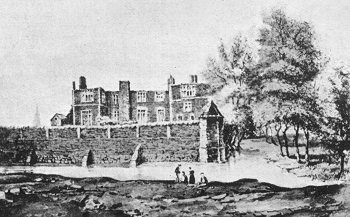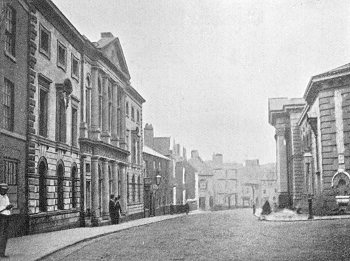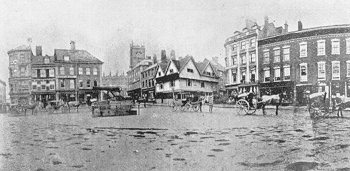The Old Hall, Town Hall and High Green The Old Hall The Old Hall was built about the reign of Elizabeth, near the site of the present Free Library, for the town residence of the Leveson family, at the time they acquired their riches by the wool trade when it was called the staple, and the dealers in it merchants. In Queen Anne's time, one of the Levesons, viz., Walter, sold a large estate, viz., the great hall, with lands belonging to it, Ashmore Park, etc., to the Earl of Bradford.
Mr. Osborn's grandfather was parson of Bilston, and his son went as a common soldier with major Leveson into Scotland and other parts. After the Revolution he settled in Wolverhampton, turned Quaker, and by keeping a shop of workmen making tobacco boxes, &c., amassed a fortune of over £10,000. The Old Hall, afterwards called Turton's Hall, was, as our readers can see, a stately residence, walled round, moated, with extensive gardens, and surrounded with trees, but eventually degenerated into a huge workshop for the manufacture of tin and japan ware, and was finally demolished in 1883. In St. Peter's Church there is a monument to the memory of John Leveson, in armour, who died in 1575 and in the chancel is a statue of brass, the only remaining vestige of a stately monument of black marble, in honour of Richard Leveson, an admiral who served under Sir Francis Drake against the Spanish Armada. The monument was destroyed by the soldiers of the Commonwealth. The Old Town Hall The old Town Hall occupied the site formerly held by the Red Lion Hotel, a place of considerable importance in the old coaching days, possessing long ranges of coachhouses and harness rooms, and stabling for over 40 horses. At the back of the "Red Lion" were a number of nicely laid out pleasure grounds and cultivated gardens owned or rented by tradesmen of the town, and covering the land through which Waterloo Road now runs. In the period antecedent to the cutting through of Darlington Street (1821) the entrance into and through the town from Compton and Tettenhall was up Salop Street (or Barn Street, as it was then called), round by Boblake, now Worcester Street, and up Cock Street. But for the convenience of the Royal.mails and ordinary stage coaches, there was a broad winding avenue branching off from the bottom of Barn Street, and leading up to the gateway entrance on that side of the Red Lion yard. The "Lion" was no mere roadside change house. It was known throughout the country as a first-class, well appointed, and well-managed hotel, and had given shelter to some of the highest and noblest in the Kingdom.
It was in the same yard a few days afterwards that Mr. Villiers met his political opponent, Mr. Nicholson, whom I had challenged respecting a slanderous statement that had been circulated, and successfully turned the tables on him. In 1832, our late Sovereign, then the Princess Victoria, accompanied by her mother, the Duchess of Kent, drove through the old gateway of the "Red Lion," and stopped to partake of refreshments whilst a change of horses was being effected for the purpose of continuing the journey to Trentham. The "Lion" was closed as a hotel in 1838, and in 1845 the premises were occupied by Mr. Wm. Bailey, who had them fitted up partly as a private residence and also for the purpose of carrying on his trade as a chemist and druggist, whilst the yard at the back was converted into a hide and skin market. Mr. Bailey relinquished his tenancy in 1855, and the town having obtained a charter of incorporation, a motion was brought forward in the Town Council, at that time holding its meetings at the old Free Library premises in Garrick Street, to purchase the old "Lion" and adjoining premises and make them suitable for a Town Hall. The property was purchased for £8,000, the front of the hotel taken down and rebuilt (as shown in our illustration) with the entrance, and the interior portion altered and enlarged at a total outlay, including the purchase money of over £10,000. The result was far from being, satisfactory, and less than 25 years afterwards the whole of the old "Lion" property was raised to the ground and the present Town Hall erected on its site at a cost of about £20,000. The foundation stone was laid in October, 1869, by the then Mayor, Alderman Ironmonger, the opening ceremony taking place two years later. After a further lapse of 30 years, it was found that the Town Hall was both inconvenient and inadequate in accommodation for the growing needs of the town. During his Mayoralty, Alderman C. T. Mander was strongly in favour of rebuilding, instead of trying to improve the Town Hall, extending its area either by taking in Corporation Street or by the purchase of the property encircled by Townwell Fold. The worthy alderman's scheme also embraced the demolition of the Exchange Hall and the pulling down of the present Market Hall, and rebuilding it on the site of the late Wholesale Market. It was a grand idea, but too prodigious for the present generation of councillors. At some future time there is no doubt Alderman Hander's idea will be realised, and Wolverhampton will possess one of the finest squares in the Kingdom, the old Church, with its proposed new entrance, occupying a grand and commanding position at the top; a new Town Hall stretching across and guarding the bottom end; a new Market Hall sheltering the off-side, and a row of educational, poor law, and County Court buildings rearing themselves opposite, with statues of the best of Wolverhampton's citizens adorning the centre. High Green, 1860 Our previous views of High Green have shown more particularly the South side. Crossing over to the North side, the thoroughfare now known as Exchange Street, was some sixty years ago a mere alley, leading to a vacant plot of land now occupied by the Market Hall, bounded on the one side by another narrow pathway bearing the name of "Pigstye Walk" (now Cheapside), and Craddock's Walk on the other. The principal "liquor shops" in High Green 80 years ago were then, as one is now, the two well-known establishments, carried on respectively by Mr. Cope and Mr. Harley, noted in those days, the one for brandy and the other for gin. Cope's liquor vaults was where it now stands at the corner leading to the Lichgates, and at the opposite corner (as shown in our illustration) was the antiquated but picturesque half-timbered structure, but remembered as "Davenhill's," but carried on 80 years back by Messrs. Cholditch and Barter.
When at length the time for its demolition arrived, a strong desire was expressed in many quarters, that this, the almost remaining relic of old Wolverhampton, should in some shape be preserved. What the Corporation (from purely economical motives) declined to do, a private individual did do and the shell of the old house-fitted together as near as possible like what it was in days gone by was erected in a quiet corner in the Rectory garden, Waterloo Road. From the " Golden Fleece," at the corner of John Street and High Street, to the "Woolpack" on Snow Hill, there could not have been less than sixteen of these old-licensed inns; yet though so numerous, they all did a thriving trade At the corner of the Market Place was another old-fashioned inn, kept by a widow named Williams with whom lodged a young man named Tasker. The penny postage was just then coming into operation, and one morning a letter arrived at the Wolverhampton office which caused no small amount of amusement. Instead of being addressed in the usual form, the inscription written outside was as follows
The letter was duly delivered and formed a subject of local gossip for some time after. |






